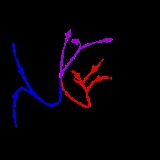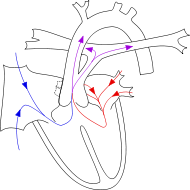
Persistent truncus arteriosus
Encyclopedia
Persistent truncus arteriosus (or Truncus arteriosus), also known as Common arterial trunk, is a rare form of congenital heart disease that presents at birth. In this condition, the embryological structure known as the truncus arteriosus
fails to properly divide into the pulmonary trunk and aorta
.
The "Type IV" proposed in 1949 is no longer considered a form of PTA by most modern sources.
Another well-known classification was defined by Van Praaghs in 1965.
). The neural crest
, specifically a population known as the cardiac neural crest, directly contributes to the aorticopulmonary septum
.
Microablation of the cardiac neural crest in developing chick embryos and genetic anomalies affecting this population of cells in rodents results in persistent truncus arteriosus.
Numerous perturbations affecting the cardiac neural crest have been associated with persistent truncus arteriosus, some of which include growth factor
s (fibroblast growth factor 8 and bone morphogenetic protein
), transcription factor
s (T-box
, Pax
, Nkx2-5
, GATA-6, and Forkhead), and gap junction
proteins (Connexin
). The cardiac neural crest also contributes the smooth muscle
of the great arteries
.
 Anatomical changes associated with this disorder includes:
Anatomical changes associated with this disorder includes:
There have been cases where the condition has not been diagnosed at birth and surgical intervention is not an option. A number of these cases have survived well into adulthood.
Truncus arteriosus (embryology)
The truncus arteriosus and bulbus cordis are divided by the aorticopulmonary septum. The truncus arteriosus gives rise to the ascending aorta and the pulmonary trunk. The caudal end of the bulbus cordis gives rise to the smooth parts of the left and right ventricles...
fails to properly divide into the pulmonary trunk and aorta
Aorta
The aorta is the largest artery in the body, originating from the left ventricle of the heart and extending down to the abdomen, where it branches off into two smaller arteries...
.
Classification
The most well-known classification was the fourfold system developed by Collett and Edwards in 1949. Collett/Edwards Types I, II, and III are distinguished by the branching pattern of the pulmonary arteries:- Type I: truncus -> one pulmonary artery -> two lateral pulmonary arteries
- Type II: truncus -> two posterior/posterolateral pulmonary arteries
- Type III: truncus -> two lateral pulmonary arteries
The "Type IV" proposed in 1949 is no longer considered a form of PTA by most modern sources.
Another well-known classification was defined by Van Praaghs in 1965.
Causes
Most of the time, this defect occurs spontaneously. Genetic disorders, and teratogens (viruses, metabolic imbalance, and industrial or pharmacological agents) have been associated as possible causes. Up to 50% (varies in studies) of cases are associated with chromosome 22q11 deletions (DiGeorge SyndromeDiGeorge syndrome
22q11.2 deletion syndrome, which has several presentations including DiGeorge syndrome , DiGeorge anomaly, velo-cardio-facial syndrome, Shprintzen syndrome, conotruncal anomaly face syndrome, Strong syndrome, congenital thymic aplasia, and thymic hypoplasia is a syndrome caused by the deletion of a...
). The neural crest
Neural crest
Neural crest cells are a transient, multipotent, migratory cell population unique to vertebrates that gives rise to a diverse cell lineage including melanocytes, craniofacial cartilage and bone, smooth muscle, peripheral and enteric neurons and glia....
, specifically a population known as the cardiac neural crest, directly contributes to the aorticopulmonary septum
Aorticopulmonary septum
The aorticopulmonary septum is developmentally formed from neural crest, specifically the cardiac...
.
Microablation of the cardiac neural crest in developing chick embryos and genetic anomalies affecting this population of cells in rodents results in persistent truncus arteriosus.
Numerous perturbations affecting the cardiac neural crest have been associated with persistent truncus arteriosus, some of which include growth factor
Growth factor
A growth factor is a naturally occurring substance capable of stimulating cellular growth, proliferation and cellular differentiation. Usually it is a protein or a steroid hormone. Growth factors are important for regulating a variety of cellular processes....
s (fibroblast growth factor 8 and bone morphogenetic protein
Bone morphogenetic protein
Bone morphogenetic proteins are a group of growth factors also known as cytokines and as metabologens . Originally discovered by their ability to induce the formation of bone and cartilage, BMPs are now considered to constitute a group of pivotal morphogenetic signals, orchestrating tissue...
), transcription factor
Transcription factor
In molecular biology and genetics, a transcription factor is a protein that binds to specific DNA sequences, thereby controlling the flow of genetic information from DNA to mRNA...
s (T-box
T-box
T-box refers to a group of transcription factors involved in limb and heart development. In humans and some other animals, defects in the TBX5 gene expression can lead to finger-like thumbs and ventricular septal defects in which there is no separation between the left and right ventricle of the...
, Pax
Pax genes
Paired box genes are a family of tissue specific transcription factors containing a paired domain and usually a partial or complete homeodomain. An octapeptide may also be present...
, Nkx2-5
NKX2-5
Homeobox protein Nkx-2.5 is a protein that in humans is encoded by the NKX2-5 gene.-Interactions:NKX2-5 has been shown to interact with GATA4 and TBX5....
, GATA-6, and Forkhead), and gap junction
Gap junction
A gap junction or nexus is a specialized intercellular connection between a multitude of animal cell-types. It directly connects the cytoplasm of two cells, which allows various molecules and ions to pass freely between cells....
proteins (Connexin
Connexin
Connexins, or gap junction proteins, are a family of structurally-related transmembrane proteins that assemble to form vertebrate gap junctions . Each gap junction is composed of two hemichannels, or connexons, which are themselves each constructed out of six connexin molecules...
). The cardiac neural crest also contributes the smooth muscle
Smooth muscle
Smooth muscle is an involuntary non-striated muscle. It is divided into two sub-groups; the single-unit and multiunit smooth muscle. Within single-unit smooth muscle tissues, the autonomic nervous system innervates a single cell within a sheet or bundle and the action potential is propagated by...
of the great arteries
Great arteries
Great arteries is a term used to refer collectively to the primary arteries of the heart, which include:* Pulmonary artery: the vessel that carries oxygen-depleted blood from the right ventricle to the lungs....
.
Anatomical changes

- single artery arising from the two ventriclesVentricle (heart)In the heart, a ventricle is one of two large chambers that collect and expel blood received from an atrium towards the peripheral beds within the body and lungs. The Atria primes the Pump...
which gives rise to both the aortic and pulmonary vessels - abnormal truncal valveTruncal valveTruncus valve is a single large arterial vessel coming out of the heart and overriding a large hold between the two ventricles known as ventricular septal defect ....
- right sided aortic archAortic archThe arch of the aorta or the transverse aortic arch is the part of the aorta that begins at the level of the upper border of the second sternocostal articulation of the right side, and runs at first upward, backward, and to the left in front of the trachea; it is then directed backward on the left...
in about 30% of cases (not shown) - large ventricular septal defectVentricular septal defectA ventricular septal defect is a defect in the ventricular septum, the wall dividing the left and right ventricles of the heart.The ventricular septum consists of an inferior muscular and superior membranous portion and is extensively innervated with conducting cardiomyocytes.The membranous...
- pulmonary hypertensionPulmonary hypertensionIn medicine, pulmonary hypertension is an increase in blood pressure in the pulmonary artery, pulmonary vein, or pulmonary capillaries, together known as the lung vasculature, leading to shortness of breath, dizziness, fainting, and other symptoms, all of which are exacerbated by exertion...
- complete mixing occurring at level of the great vessel
- right-to-left shunting of blood
Clinical manifestations
- CyanosisCyanosisCyanosis is the appearance of a blue or purple coloration of the skin or mucous membranes due to the tissues near the skin surface being low on oxygen. The onset of cyanosis is 2.5 g/dL of deoxyhemoglobin. The bluish color is more readily apparent in those with high hemoglobin counts than it is...
presents at birth - Heart failure may occur within weeks
- SystolicSystole (medicine)Systole is the contraction of the heart. Used alone, it usually means the contraction of the left ventricle.In all mammals, the heart has 4 chambers. The left and right ventricles pump together. The atria and ventricles pump in sequence...
ejection murmurMurmurMurmur usually means:*Murmur , a soft-sounded and quiet utterance/talking "under your breath" so it is hard to understand what the speaker is saying*Breathy voice, a type of phonation in speechIt can also refer to:-Medical:...
is heard at the left sternal border - Widened pulse pressurePulse pressurePulse Pressure is most easily defined as being the amount of pressure required to create the feeling of a pulse. Measured in millimeters of mercury , the pressure difference between the systolic and diastolic pressures give you the amount of pressure change to create the pulse, which is the pulse...
- Bounding arterial pulses
- Loud second heart sound
- Biventricular hypertrophy
- CardiomegalyCardiomegalyCardiomegaly is a medical condition wherein the heart is enlarged. It is generally categorized in the following manner:* Cardiomegaly due to dilation* Cardiomegaly due to ventricular hypertrophy** Left ventricular hypertrophy...
- Increased pulmonary vascularity
- Hypocalcemia (if associated with DiGeorge syndromeDiGeorge syndrome22q11.2 deletion syndrome, which has several presentations including DiGeorge syndrome , DiGeorge anomaly, velo-cardio-facial syndrome, Shprintzen syndrome, conotruncal anomaly face syndrome, Strong syndrome, congenital thymic aplasia, and thymic hypoplasia is a syndrome caused by the deletion of a...
)
Treatment
Treatment is with neonatal surgical repair. The ventricular septal defect is closed with a patch. The pulmonary arteries are then detached from the common artery (truncus arteriosus) and connected to the right ventricle using a tube (a conduit or tunnel).There have been cases where the condition has not been diagnosed at birth and surgical intervention is not an option. A number of these cases have survived well into adulthood.
External links
- Pediatric Heart Surgery
- The Congenital Heart Surgery Video Project
- Truncus Arteriosus Repair in a Premature Newborn Baby
- Surgery for Truncus Arteriosus: Powerpoint™ Presentation
- Truncus Arteriosus Cincinnati Children's Medical Center
- Truncus Arteriosus information from Seattle Children's Hospital Heart Center
- Diagram at kumc.edu
- Overview at University of MichiganUniversity of MichiganThe University of Michigan is a public research university located in Ann Arbor, Michigan in the United States. It is the state's oldest university and the flagship campus of the University of Michigan...

